Délka křivky
Určete délku grafu funkce ![]()
| > | k:=ln(x); |
![]()
| > | plot(ln(x), x=sqrt(3)..sqrt(15)); |
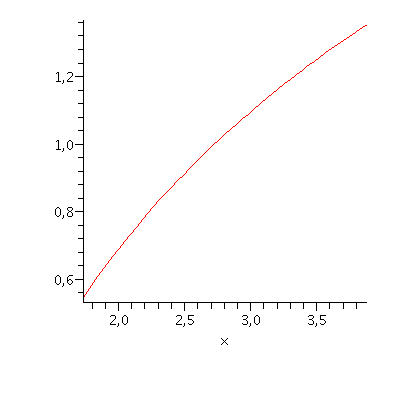
| > | diff(ln(x), x); |
![]()
| > | plot(%, x=sqrt(3)..sqrt(15)); |
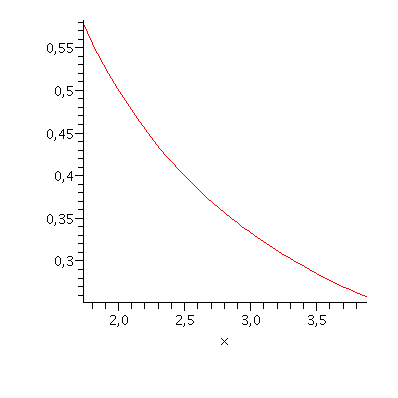
| > | l:=Int(sqrt(1+(Diff(k,x))^2), x=sqrt(3)..sqrt(15)); |
![(Typesetting:-mprintslash)([l := Int((1+(Diff(ln(x), x))^2)^(1/2), x = 3^(1/2) .. 15^(1/2))], [Int((1+(Diff(ln(x), x))^2)^(1/2), x = 3^(1/2) .. 15^(1/2))])](imagesaplikace/aplikace_6.gif)
| > | l:=Int(sqrt(1+(diff(k,x))^2), x=sqrt(3)..sqrt(15)); |
![(Typesetting:-mprintslash)([l := Int((1+1/x^2)^(1/2), x = 3^(1/2) .. 15^(1/2))], [Int((1+1/x^2)^(1/2), x = 3^(1/2) .. 15^(1/2))])](imagesaplikace/aplikace_7.gif)
| > | with(student): |
| > | simplify(changevar(x^2+1=t^2, l, t)); |
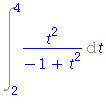
| > | value(%); |
![]()
Určete délku kružnice o poloměru ![]() Kružnici zadejte parametricky.
Kružnici zadejte parametricky.
| > | plot([cos(t), sin(t), t=0..2*Pi],scaling=constrained); |
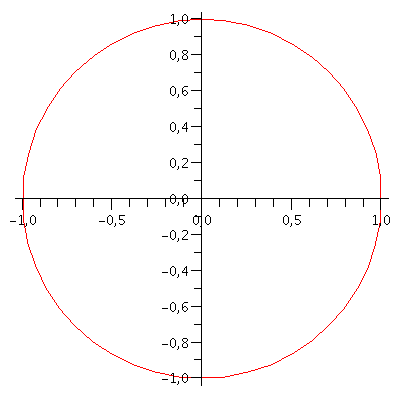
| > | m:=Int(sqrt((Diff(cos(t),t)^2)+(Diff(sin(t), t))^2), t=0..2*Pi); |
![(Typesetting:-mprintslash)([m := Int(((Diff(cos(t), t))^2+(Diff(sin(t), t))^2)^(1/2), t = 0 .. 2*Pi)], [Int(((Diff(cos(t), t))^2+(Diff(sin(t), t))^2)^(1/2), t = 0 .. 2*Pi)])](imagesaplikace/aplikace_12.gif)
| > | value(m); |
![]()
Určete délku asteroidy.
| > | plot([(cos(t))^3, (sin(t))^3, t=0..2*Pi], scaling=constrained); |
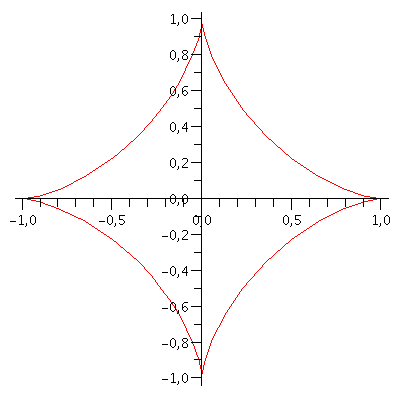
| > | d:=4*Int(sqrt(Diff((cos(t))^3,t)^2+ Diff((sin(t))^3,t)^2), t=0..Pi/2); |
![(Typesetting:-mprintslash)([d := 4*Int(((Diff(cos(t)^3, t))^2+(Diff(sin(t)^3, t))^2)^(1/2), t = 0 .. 1/2*Pi)], [4*Int(((Diff(cos(t)^3, t))^2+(Diff(sin(t)^3, t))^2)^(1/2), t = 0 .. 1/2*Pi)])](imagesaplikace/aplikace_15.gif)
| > | simplify(value(d)); |
![]()
| > |
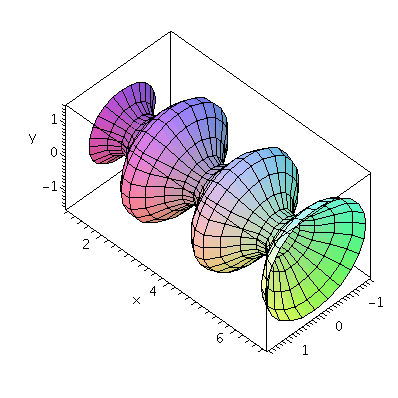
![(Typesetting:-mprintslash)([v := Pi*Int((1+1/2*sin(3*x))^2, x = 1/3*Pi .. 13/6*Pi)], [Pi*Int((1+1/2*sin(3*x))^2, x = 1/3*Pi .. 13/6*Pi)])](imagesaplikace/aplikace_24.gif)

![(Typesetting:-mprintslash)([v := Pi*Int(4*abs(sin(x))^2, x = 0 .. 2*Pi)], [Pi*Int(4*abs(sin(x))^2, x = 0 .. 2*Pi)])](imagesaplikace/aplikace_32.gif)
![(Typesetting:-mprintslash)([s := 2*Pi*Int(2*abs(sin(x))*(1+(Diff(2*abs(sin(x)), x))^2)^(1/2), x = 0 .. 2*Pi)], [2*Pi*Int(2*abs(sin(x))*(1+(Diff(2*abs(sin(x)), x))^2)^(1/2), x = 0 .. 2*Pi)])](imagesaplikace/aplikace_34.gif)
![(Typesetting:-mprintslash)([v := Pi*Int(r^2-x^2, x = -r .. r)], [Pi*Int(r^2-x^2, x = -r .. r)])](imagesaplikace/aplikace_38.gif)
![(Typesetting:-mprintslash)([s := 2*Pi*Int((r^2-x^2)^(1/2)*(1+(Diff((r^2-x^2)^(1/2), x))^2)^(1/2), x = -r .. r)], [2*Pi*Int((r^2-x^2)^(1/2)*(1+(Diff((r^2-x^2)^(1/2), x))^2)^(1/2), x = -r .. r)])](imagesaplikace/aplikace_40.gif)